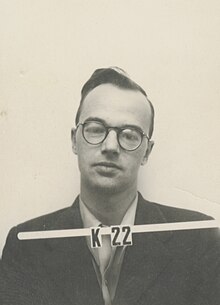
Back جواسيس نووية Arabic Espies atòmics Catalan Atomspionage German Espía atómico Spanish جاسوسان اتمی Persian Mata-mata atom ID Szpiedzy atomowi Polish Espiões atômicos Portuguese Spionaj atomic Romanian Атомные шпионы Russian

Atomic spies or atom spies were people in the United States, the United Kingdom, and Canada who are known to have illicitly given information about nuclear weapons production or design to the Soviet Union during World War II and the early Cold War. Exactly what was given, and whether everyone on the list gave it, are still matters of some scholarly dispute. In some cases, some of the arrested suspects or government witnesses had given strong testimonies or confessions which they recanted later or said were fabricated. Their work constitutes the most publicly well-known and well-documented case of nuclear espionage in the history of nuclear weapons. At the same time, numerous nuclear scientists wanted to share the information with the world scientific community, but this proposal was firmly quashed by the United States government. It is worth noting that many scientists who worked on the Manhattan Project were deeply conflicted about the ethical implications of their work, and some were actively opposed to the use of nuclear weapons.
Atomic spies were motivated by a range of factors. Some, such as ideology or a belief in communism, were committed to advancing the interests of the Soviet Union. Others were motivated by financial gain, while some may have been coerced or blackmailed into spying. The prospect of playing a role in shaping the outcome of the Cold War may also have been appealing to some. Another large motivational factor was to be engrained into the history of the world, and to be remembered as someone who did something larger than themselves. Regardless of their specific motivations, each individual played a major role in the way the Cold War unfurled and the current state of nuclear weapons.
Confirmation about espionage work came from the Venona project, which intercepted and decrypted Soviet intelligence reports sent during and after World War II. In 1995, the U.S. declassified its Venona Files which consisted of deciphered 1949 Soviet intelligence communications.[1] These provided clues to the identity of several spies at Los Alamos and elsewhere, some of whom have never been identified. These decrypts prompted the arrest of naturalized British citizen Klaus Fuchs in 1950.[2] Fuchs’ confession led to the discovery of spy Harry Gold who served as his Soviet courier.[3] Gold identified spy David Greenglass, a Los Alamos Army-machinist. Greenglass identified his brother-in-law, spy Julius Rosenberg, as his control.[2] The Venona Files corroborated their espionage activities and also revealed others in the network of Soviet spies, including physicist Theodore Hall who also worked at Los Alamos.[4] Some of this information was available to the government during the 1950s trials, but it was not usable in court as it was highly classified. Additionally, historians have found that records from Soviet archives, which were briefly opened to researchers after the fall of the Soviet Union, included more information about some spies.
Transcription of declassified Soviet KGB documents by ex-KGB officer Alexander Vassiliev provides additional details about Soviet espionage from 1930 to 1950, including the greater extent of Fuchs, Hall, and Greenglass's contributions.[4] In 2007, spy George Koval, who worked at both Oak Ridge and Los Alamos, was revealed.[5] According to Vassiliev's notebooks, Fuchs provided the Soviet Union the first information on electromagnetic separation of uranium and the primary explosion needed to start the chain reaction, as well as a complete and detailed technical report with the specifications for both fission bombs.[4] Hall provided a report on Los Alamos principle bomb designs and manufacturing, the plutonium implosion model, and identified other scientists working on the bomb.[4] Greenglass supplied information on the preparation of the uranium bomb, calculations pertaining to structural issues with it, and material on producing uranium-235.[4] Fuchs’ information corroborated Hall and Greenglass.[6][4] Koval had access to critical information on dealing with the reactor-produced plutonium's fizzle problem, and how using manufactured polonium corrected the problem.[5] With all the stolen information, Soviet nuclear ability was advanced by several years at least.[2]
- ^ Earl., Haynes, John (2010). Spies : the rise and fall of the KGB in America. Yale University Press. ISBN 978-0-300-16438-1. OCLC 449855597.
{{cite book}}: CS1 maint: multiple names: authors list (link) - ^ a b c McKnight, David (2012-12-06). Espionage and the Roots of the Cold War. Routledge. doi:10.4324/9780203045589. ISBN 978-1-136-33812-0.
- ^ Haynes, John Earl; Klehr, Harvey (2006). Early Cold War Spies. Cambridge: Cambridge University Press. doi:10.1017/cbo9780511607394. ISBN 978-0-511-60739-4.
- ^ a b c d e f Earl., Haynes, John (2009). Spies : the rise and fall of the KGB in America. Yale University Press. ISBN 978-0-300-12390-6. OCLC 778334787.
{{cite book}}: CS1 maint: multiple names: authors list (link) - ^ a b "George Koval: Atomic Spy Unmasked". Smithsonian Magazine. Retrieved 2022-04-16.
- ^ Haynes, John Earl; Klehr, Harvey (2006), "Introduction: Early Cold War Spy Cases", Early Cold War Spies, Cambridge: Cambridge University Press, pp. 1–22, doi:10.1017/cbo9780511607394.002, ISBN 9780521674072, retrieved 2022-04-16
© MMXXIII Rich X Search. We shall prevail. All rights reserved. Rich X Search